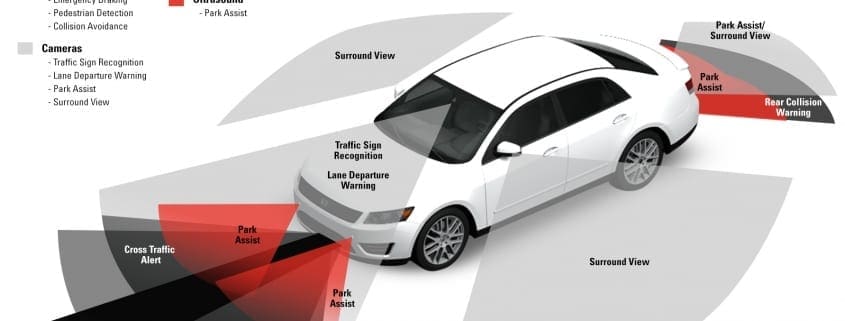Advanced Driver Assist Systems – ADAS
– FOR BEST VIEWING, CLICK HERE FOR THE PDF MAGAZINE ARTICLE –Advanced Driver Assistance Systems – ADAS

When faced with today’s seemingly endless
barrage of new technology, sometimes
you need to pick your battles. This means
researching which emerging technologies provide a
business opportunity to dive head-first into and which
ones should be waited and watched on as you gather your
troops.
Advanced driver-assist system (ADAS) technology is currently
the buzz-talk in overseas repair markets. In this article I hope to
increase talk of it here in Australia and get you thinking about the
battle ahead.
Features such as the anti-lock braking system (ABS) and
electronic stability control (ESC) have now become mandatory
and these more advanced driver-assist systems – which are
already rolling out as selling features on higher spec models – are
headed the same way.
You likely already have ADAS-equipped vehicles coming into your
workshop for routine oil changes and repairs, sometimes without
you even knowing of the technology that lurks beneath.
People are driving cars equipped with ADAS technology and do
not understand or know what is going on with their vehicle. This
is leading to driveability complaints that are actually just part of
normal operation.
We’ve lived through this all before – who hasn’t experienced a
customer complaining about the brake pedal pulsing and making
a weird noise when they brake hard in the wet? We see this as an
opportunity to educate them that the ABS is operating as it should
and it should be the same with ADAS.
Even if you don’t plan to dive into ADAS calibration – and, hey,
I wouldn’t blame you at this early stage – it’s important to start
preparing. A fundamental
knowledge of the system
will give you the confidence
to help educate that
customer who never
indicates their lane changes
and is now complaining
about their haptic-feedback
steering wheel shaking
occasionally.
ADAS is touching almost
every module of the
modern car and this article
would be a novel if we
were to discuss each and
every system at length.
To brush up on your
base-level knowledge,
go to www.wikipedia.org/
wiki/Advanced_driverassistance_systems. Here you’ll find an easy-to-digest and
comprehensive list of current ADAS systems, with links to listed
items that will give you a basic knowledge of the system and
manufacturer-specific acronyms and nuances. It’s the perfect start
to your research.
ADAS technology relies on components uncommon to the general
workshop and these all need to be understood. Along with
cameras, one of the most commonly used technologies is radiodetection and ranging, which we all know as radar.
This sends out radio waves
and uses the returning
frequencies to measure and
map out surrounding objects
and landscapes.
Most manufacturers are putting their research and development
dollars into light-detection and ranging (LIDAR) technology,
which uses invisible lasers to build a digital image that is then
interpreted by the vehicle’s artificial intelligence (AI).
One of the biggest advantages of LIDAR is the ability of its
sensors to create an incredibly precise image, offering accuracy
within a few centimetres even at long distances. This makes
it useful for pedestrian-detection systems, collision-warning
systems and cross-traffic alert technology.
LIDAR, however, doesn’t work quite so well in the case of
closer objects or in the rain, snow or fog, so radar, ultrasound,
cameras and thermal imaging will all play a part in ADAS and the
progression to autonomous vehicles.
Tesla’s Elon Musk, as ever against the grain, has branded LIDAR
a ‘fool’s errand’, saying anyone relying on the technology will be
‘doomed’.
Deeper investigation shows heavy-hitting researchers such as
Cornell University agree with his vision of a LIDAR-less ADAS
future, saying they have achieved LIDAR-like resolution using
multiple cameras.
Many manufacturers are
fumbling their way through
the implementation of
ADAS and mandating
repairs in a learning-onthe-run fashion. My advice
for the general workshop,
however, would be to wait,
watch and prepare.
Start your training and
research on this technology
but to be profitable in this
sector and recoup your
investment as an ADAS
calibration shop the bulk
of your entire workload
needs to ADAS calibrations,
mainly for trade customers.
While I’m sure tech-savvy
TaT members such as
yourself are capable of performing the necessary diagnostics and
calibrations on these systems, the price of targets and equipment
– which usually differ from manufacturer to manufacturer and
are often run up to the tens of thousands of dollars – is a limiting
factor.
Many aftermarket targets and scan-tool functionalities are
becoming available in this area but they also open a can of
worms about liability in the event of an accident.
2 3
1
Various components perform specific
jobs in your common ADAS system.
The bracket was bent back for
diagnostic purposes. Proper
repair required a new bracket and
recalibration of the radar using
specific targets.
Physical faults are common.
This bracket for the forward radar
is badly bent, causing a warning
message and disabling the intelligent
cruise control (ICC) system.
The Automotive Technician 9
You can achieve an incorrect calibration with an OEM scan tool
and an OEM target, and proper calibration with an aftermarket
tool and target – and vice versa. More important factors in the
successful repair of these technologies are the technician reading
and following the proper service information, and their attention to
detail.
With ADAS the industry now
faces a large challenge to
become competent at many of
the basic services it’s performed
for decades, from alignments
and brake servicing to steering
and suspension repair. Correct
operation of ADAS technology
assumes that all of these
fundamental systems are in
factory working order – the lack
of accuracy from less than perfect
workmanship or aftermarket parts
that was once tolerated won’t slide
with these systems.
Many modern technicians are relying on what has got them by
before – experience-based information. You punch out a quick
Facebook post saying ‘Hey, have you aligned this Honda radar
before?’. Someone responds, ‘Sure mate, draw some squares on
some paper and mount it about waist height three steps in front
of the car, that got the light out for me.’. That kind of scenario just
isn’t going to fly on these future vehicles.
A misaligned ADAS system may well still appear to function but
is akin to a drunk driver not seeing straight. You need to be fine
telling a customer, ‘No, I don’t have the tooling to complete this
repair safely’ or subcontracting the calibrations out to an ADAS
specialty shop or dealer.
At this early stage this technology has an inherent conflict. On
one hand, if you are able to complete the repair, you can charge
accordingly and word will spread that you are the high-tech shop
in town. But if procedures are not followed and completed to exact
specifications, you may find yourself liable for serious property
damage or personal injury in the event of an accident.
The main gamechanger we
should all be hoping for before
ADAS calibration becomes truly
mainstream is the introduction
of industry standards across
manufacturers, much like the
mandate of the OBDII diagnostic
connector compared to OBD1 and
prior systems.
The ongoing push for factory
service information – which we are
making inroads on thanks to the
‘Right To Repair’ work of industry
groups such as the Australian
Automotive Aftermarket Association
(AAAA) and Automotive Repairers Council of Australia (ARCA) –
will become an absolute necessity rather than just a convenience.
I urge you to utilise the great resources of aftermarket data
suppliers such as Autodata. They have vast libraries beyond
what you see online, and have always been happy to dig up
relevant vehicle data whenever I’ve made the call to them. Online
resources such as www.diag.net offer education and discussion
on high-level subjects such as ADAS. There are also training
opportunities to take advantage of – Bosch, for one, runs an
ADAS training course, which you’ll find listed on our training page
near the back of the magazine.







